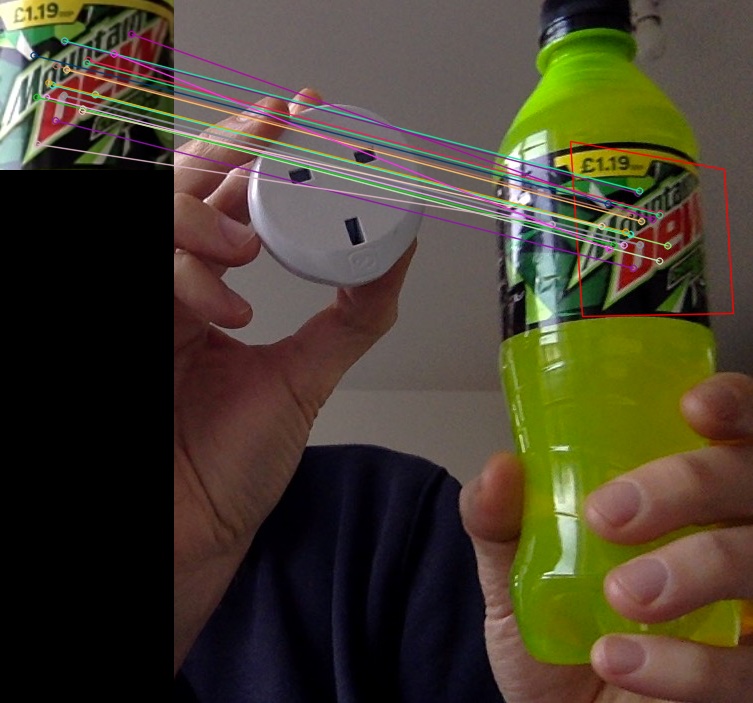How to exclude outliers from detected Orb features?
I am using the approach shown below (see bottom of post) to detect an object within a video stream.
As can be seen from the image below (red arrows) I get a number of false points / outliers outside the detected area, especially if I move the detected object. What I would like to do is draw a rectangle around the main cluster of points as returned by cv2.perspectiveTransform(), excluding the outlying points. What is the best way to achieve this?
UPDATE: I have updated the image below to hopefully show more clearly what I'm trying to achieve

#!/usr/bin/python3
# 2017.11.26 23:27:12 CST
## Find object by orb features matching
import numpy as np
import cv2
imgname = "box.png" # query image (small object)
imgname2 = "box_in_scene.png" # train image (large scene)
MIN_MATCH_COUNT = 4
## Create ORB object and BF object(using HAMMING)
orb = cv2.ORB_create()
img1 = cv2.imread(imgname)
img2 = cv2.imread(imgname2)
gray2 = cv2.cvtColor(img2, cv2.COLOR_BGR2GRAY)
gray1 = cv2.cvtColor(img1, cv2.COLOR_BGR2GRAY)
## Find the keypoints and descriptors with ORB
kpts1, descs1 = orb.detectAndCompute(gray1,None)
kpts2, descs2 = orb.detectAndCompute(gray2,None)
## match descriptors and sort them in the order of their distance
bf = cv2.BFMatcher(cv2.NORM_HAMMING, crossCheck=True)
matches = bf.match(descs1, descs2)
dmatches = sorted(matches, key = lambda x:x.distance)
## extract the matched keypoints
src_pts = np.float32([kpts1[m.queryIdx].pt for m in dmatches]).reshape(-1,1,2)
dst_pts = np.float32([kpts2[m.trainIdx].pt for m in dmatches]).reshape(-1,1,2)
## find homography matrix and do perspective transform
M, mask = cv2.findHomography(src_pts, dst_pts, cv2.RANSAC,5.0)
h,w = img1.shape[:2]
pts = np.float32([ [0,0],[0,h-1],[w-1,h-1],[w-1,0] ]).reshape(-1,1,2)
dst = cv2.perspectiveTransform(pts,M)
## draw found regions
img2 = cv2.polylines(img2, [np.int32(dst)], True, (0,0,255), 1, cv2.LINE_AA)
cv2.imshow("found", img2)
## draw match lines
res = cv2.drawMatches(img1, kpts1, img2, kpts2, dmatches[:20],None,flags=2)
cv2.imshow("orb_match", res);
cv2.waitKey();cv2.destroyAllWindows()



I don't see nothing wrong. Fortunately, I used same ORB. Can you post orignal image?
mind you, this will only work IF your object is actually in the scene. you cannot detect absence of it like that.
(this is NOT "object-detection")
@supra56 the code is working as expected, I simply want to add an additional step to remove points from the matches. I've updated the image to hopefully explain this better.
@postlude. I tested it and it working now that excluding points that youre mentioned. But I need 2 orignal images. So I can test it with your code before I post answer.
@supra56 Here are links to the exact images used in the example: https://www.dropbox.com/s/jmvm2d1w9np...https://www.dropbox.com/s/h1p0lyjghgy...
Thanks for images. I will used this for
cv2.perspectiveTransform, etc.